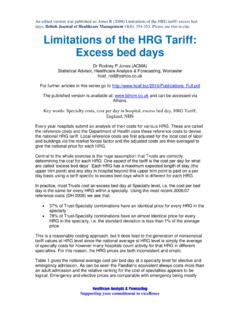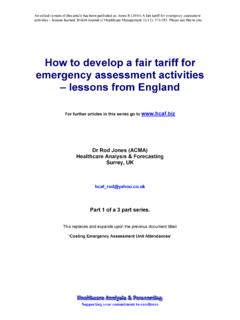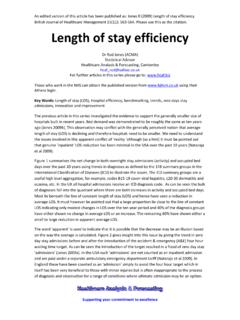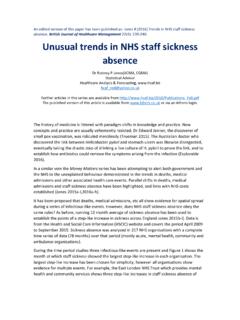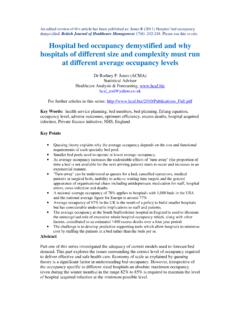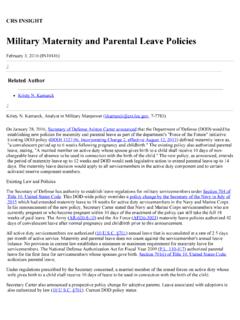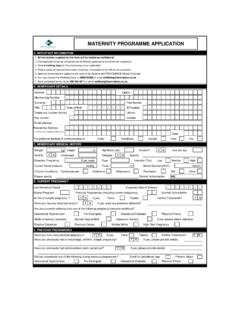Transcription of British Journal of Healthcare Management …
1 An edited version has been published as: Jones R (2018) maternity length of stay efficiency and neonatal admissions. British Journal of Healthcare Management 24(3): 122-124. Please use this to cite. maternity length of stay efficiency and neonatal admissions Dr Rodney Jones Statistical Advisor Healthcare Analysis & Forecasting Part of a longer series available at The published version is available at and can be accessed via an Athens login Key Points LOS is not always a measure of efficiency Congress in the USA had to stipulate a minimum LOS to protect mothers from too rapid discharge following birth Some 41% of maternity admissions in England are discharged on the same day as admission This has distorted the calculation of maternity average LOS. The number of neonatal admissions per 1,000 births in England rapidly rose after 2004/05 when the real maternity LOS dropped below days Costs have simply been shifted to another specialty Everyone in the UK NHS knows' that a shorter length of stay (LOS) is a good' measure of efficiency'.
2 Hence, we benchmark everyone against LOS and castigate the inefficient wasters at the bottom of the ranking. LOS does, however, greatly depend on the ability to discharge patients into the surrounding non-acute environment which includes hospices, nursing homes, step-down facilities in community hospitals, community nurses supporting in-home care, transfers to specialist hospitals and dedicated rehabilitation facilities. In this case international and national hospital LOS efficiency' is a debatable term (Jones 2009, 2010, 2013), and most doctors would rightly point out that patients are generally not kept in hospital any longer than is necessary. In the early 1990's maternity units in the USA came under intense pressure from insurance companies to reduce LOS, on the basis that one extra day cost more, the cost apportionment fallacy (Jones 2013b). As a result, LOS reduced very rapidly to the point that mother and baby were exposed to high risk of out-of-hospital complications.
3 In 1996. Congress was forced to pass legislation which stipulated a minimum stay of 48 hours An edited version has been published as: Jones R (2018) maternity length of stay efficiency and neonatal admissions. British Journal of Healthcare Management 24(3): 122-124. Please use this to cite. following vaginal delivery and 96 hours following a caesarean section, unless by agreement of physician and mother (National Conference of State Legislatures 2012). Some 41% of all maternity overnight' admissions in England are same day stay see Table 1 for a sample of diagnoses accounting for the most maternity beds. This arises as a quirk of the definition of an overnight' admission, within the NHS Data Dictionary, which assigns an overnight classification to anything not an elective day case irrespective of length of stay (NHS Digital 2017). These same day admissions arise from the role of maternity units as an assessment unit' for events occurring during pregnancy such as excessive bleeding and other medical complications.
4 However, the problem arises in that all these same day stay admissions are attributed a zero day stay in the calculation of average LOS (Jones 2017). To this end Fig. 1 shows the official' average LOS for English maternity units and an estimate of the real LOS for those patients who stay overnight. This is achieved by attributing a notional LOS of days to the count of all zero day stay admissions which is then added into the numerator. Table 1: Top 15 diagnoses for pregnancy and childbirth ranked by number of occupied beds in England Change Change Same Average Occupied in LOS in LOS day ICD-10 Description real Beds since since stay LOS. 99/00 07/08 (%). O68 Labour and delivery with fetal stress 859 4%. O70 Perineal laceration during delivery 630 21%. O36 Maternal care for other fetal problems 523 69%. O63 Long labour 380 2%. O34 Maternal care for abnormality of pelvic organs 305 9%.
5 O26 Maternal care for other conditions 279 67%. O32 Maternal care for malpresentation 226 22%. O42 Premature rupture of membranes 220 39%. O72 Postpartum haemorrhage 140 16%. O14 Gestational hypertension with proteinuria 134 15%. O99 Other maternal diseases 134 51%. O24 Diabetes mellitus in pregnancy 123 19%. O80 Single spontaneous delivery 119 35%. O60 Preterm delivery 116 9%. O21 Excessive vomiting in pregnancy 114 30%. O46 Antepartum haemorrhage 104 47%. O04 Medical abortion 98 86%. O03 Spontaneous abortion 92 63%. O62 Abnormalities of forces of labour 92 9%. O48 Prolonged pregnancy 82 19%. O44 Placenta praevia 77 13%. Footnote: Data is from Hospital Episode Statistics (NHS Digital 2017a) and covers the years 1998/99. to 2016/17. Occupied beds, Average real LOS and Same day stay are an average of 2015/16 and 2016/17. Change in LOS is in days. A direct count of same day admissions is available from 2013/14.
6 Onward. Same day admissions have been apportioned to the prior years based on total admissions. An edited version has been published as: Jones R (2018) maternity length of stay efficiency and neonatal admissions. British Journal of Healthcare Management 24(3): 122-124. Please use this to cite. As can be seen the real LOS is about days higher than the official figure. Also, that average LOS has not fundamentally changed since 2007/08 and is increasing in recent years. The key point here is that the real average LOS needs to be used to calculate overnight occupied beds, while an accurate measure of same day LOS, in hours and minutes, needs to be used to calculate the additional beds to accommodate these patients (Tierney and Conroy 2012). The national average occupancy margin (calculated at midnight), which excludes same day stay admissions, is therefore a gross underestimate of the true situation.
7 Disastrously undersized maternity units can then be built based on such fallacious figures. Figure 1: Apparent and real average LOS for maternity units in England and associated neonatal admissions per 1,000 births 410. Real LOS. Apparent LOS 390. Admissions per 1,000 births Neonatal admissions 370. LOS (days). 350. 330. 310. 290. 270. 250. Footnote: Data is from HES (NHS Digital 2017a). A direct count of same day admissions is available from 2013/14 onward. Same day admissions have been apportioned to the prior years based on total admissions. As in the USA, the impact of over-enthusiastic reduction in maternity LOS can be discerned in Figure 1 where neonatal admissions per 1,000 births escalates at the point where the real LOS drops below days. These have been termed boomerang babies' (Sacchetti et al 1997), and simply shift costs to somewhere else in the system.
8 In conclusion, average LOS in English maternity units probably needs to revert back to days to prevent excessive re-admission of neonates. The use of LOS as a blunt efficiency measure only creates false comparisons and can lead to more harm than good. An edited version has been published as: Jones R (2018) maternity length of stay efficiency and neonatal admissions. British Journal of Healthcare Management 24(3): 122-124. Please use this to cite. References Jones R. Length of stay efficiency. BJHCM 2009; 15(11): 563-564. Jones R. Benchmarking length of stay. BJHCM 2010; 16(5): 248-250. Jones R. Average length of stay in hospitals in the USA. BJHCM 2013a; 19(4): 186-191. Jones R. A guide to maternity costs why smaller units have higher costs. Brit J Midwifery 2013b; 21(1): 54-59. Jones R. What is driving growth in the English NHS? BJHCM 2017; 23(3): 134-137. National Conference of State Legislatures.
9 Final maternity length of stay rules. 2012. NHS Digital. Hospital Episode Statistics, 2016/17, 2017a. NHS Digital. NHS Data Model and Dictionary, V3. 2017b; Sacchetti A, Gerardi M, Sawchuk P, Bihl I. Boomerang babies: Emergency department utilization by early discharge babies. Pediatr Emerg Care 1997; 13(6): 365-368. Tierney L, Conroy K. Optimal occupancy in the ICU: A literature review. Aust Critical Care 2014; 27: 77-84.
